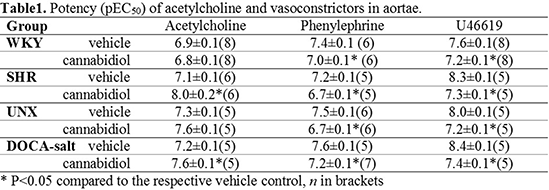Print version
Search Pub Med
| 011P London, UK 8th European Workshop on Cannabinoid Research |
Influence of cannabidiol on vascular function in hypertension
Introduction:Cannabidiol has been suggested to be a beneficial treatment of cardiovascular disorders. It directly relaxes human and rat arteries and augments endothelial function in Zucker diabetic fatty rats1. The aim of the study was to determine the influence of cannabidiol on vascular function in hypertensive rats.
Methods: Experiments were performed in the isolated endothelium-intact thoracic aortae isolated from male spontaneously (SHR) or deoxycorticosterone acetate and high salt-diet treated (DOCA-salt) hypertensive Wistar rats or their appropriate normotensive controls Wistar Kyoto (WKY) or uninephrectomized Wistar (UNX) rats using organ bath technique2. Aortae were incubated for 2h with cannabidiol (10 μM) or vehicle (10 μl), then cumulative concentration-response curves were conducted: (1) to acetylcholine (0.0001 - 3 μM) in phenylephrine pre-constricted aortae and (2) to phenylephrine (0.0001 - 30 μM) and a thromboxane A2 analog U46619 (0.0001 - 3 μM). In each individual preparation only one experimental curve was determined. Results are shown as means ± SEM of n animals as (1) % of relaxation of phenylephrine (10 μM)-induced contraction or (2) % of contraction of KCl (60 mM)-induced tone, respectively. Statistical comparisons were made using Student's unpaired t-test. P<0.05 was considered as significant.
Results: Cannabidiol by itself did not change basal tone but its incubation increased potency of acetylcholine-induced vasorelaxation without changes in maximal response in both model of hypertension but not in respective normotensive strains when compared to vehicle-treated artery (Table 1). Treatment with cannabidiol attenuated the phenylephrine- and U46619-induced vasoconstrictor potency (Table 1). The maximal response was reduced only in phenylephrine-evoked vasoconstriction in normo- and hypertensive animals; Rmax (cannabidiol vs vehicle): WKY 52.5±3.7 vs 79.8±2.5; SHR 54.7±4.2 vs 74.5±3.1; UNX 51.6±3.9 vs 82.8±4.0; DOCA-salt 82.4±2.3 vs 92.3±2.7, P<0.05.
Conclusions: The beneficial effect of cannabidiol in hypertension (model-independently) may be partially due to improved endothelium-dependent vasorelaxation and/or reduced vasoconstriction.
References:
1. Wheal AJ et al. (2017). Front Pharmacol 8:248.
2. Baranowska-Kuczko M et al. (2016). Life Sci 151:288-299.
Supported by grants from the National Science Centre (Poland) (No 2015/19/B/NZ7/02270) and the Medical University of Białystok (N/ST/ZB/16/005/2213)


